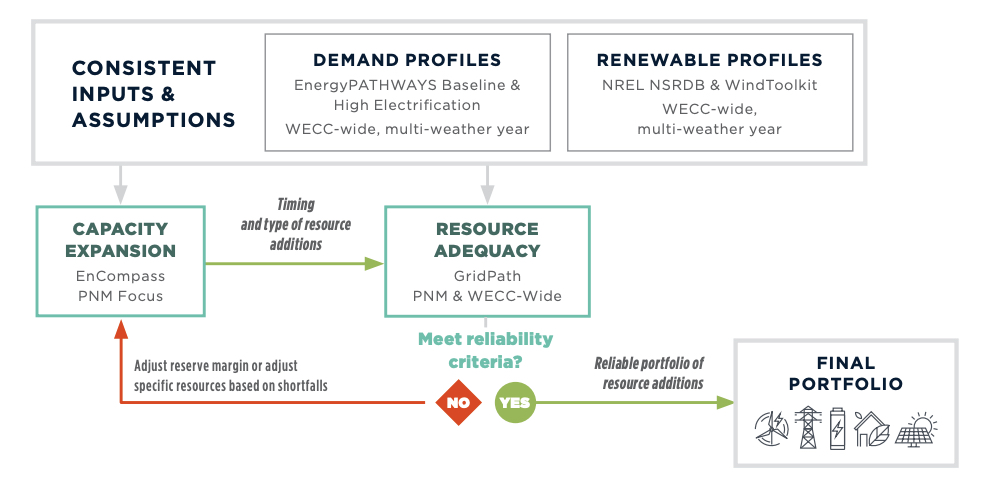New Mexico utility PNM contributed data, scrubbed of sensitive information, to a study that identified three possible pathways to reliably providing 100% clean electricity.
All three pathways would greatly expand PNM’s solar, wind and storage capacity, but each would take a different approach to reliability at 100% clean energy. One pathway would integrate “emerging clean firm technologies,” the second would take advantage of expanded regional coordination, and the third would “upsize” wind and solar deployment.
“Given the complexity of modern resource planning as PNM’s system moves toward 100% carbon-free electricity,” said Nick Phillips, the utility’s director of integrated resource planning, “we appreciate that independent studies are placing a higher focus on decarbonization to ensure a safe and reliable energy transition.” He said that PNM may use the study results “as data points for comparison to existing modeling results.”
New Mexico’s Energy Transition Act requires utilities to reach 40% renewables by 2025, 50% renewables by 2030, and 100% clean energy by 2045, with the final target subject to considerations of safety, reliability and customer bill impacts. PNM has set a goal to be emissions-free by 2040.
To launch the study, PNM provided the database it had used with the EnCompass resource planning model to prepare its most recent integrated resource plan.
The consultancy GridLab, with help from a team of experts, then used that database and the EnCompass model to develop possible 100% clean resource portfolios, which were tested for resource adequacy using the GridPath model, in an iterative process shown at the bottom of the flow chart below.

Image: GridLab
The study found that the lowest-cost approach for PNM to serve its 525,000 customers with a 100% clean reliable grid, given the current extent of regional coordination, would be to add 660 MW of utility-scale solar, 770 MW of wind, plus 620 MW of wind and solar to power electrolysis of water to produce hydrogen. The study assumed that distributed solar capacity in PNM’s service area would grow from 270 MW last year to 765 MW in 2035, based on distributed solar’s recent growth rate in New Mexico, continuing at a slowing trend over time. Those amounts of added capacity would be adequate assuming a baseline level of electrification—that is, substitution of electric vehicles and other electric equipment for fossil-fueled equipment.
The hydrogen produced would fuel hydrogen combustion turbines, a clean “firm” generation resource that would substitute for fossil gas turbines to achieve reliability. Hydrogen combustion was expected to be less costly than other “emerging” clean firm resources such as geothermal or multi-day storage.
The GridLab team also modeled a 100% clean reliable grid with a high level of electrification that would require additional renewable generation. Either way, PNM’s annual capacity builds of solar, wind and storage would need to increase substantially from the pace over the last decade, the study found.
Land use requirements for the added renewables capacity was calculated to range from 0.05% to 0.28% of New Mexico’s total land area. Water requirements for hydrogen production would equal 5-6% of the water currently used by PNM’s thermal generators.
Expanded regional coordination
Having modeled that “emerging clean firm technologies” pathway to reliable generation, the study team evaluated a second pathway: “expanded regional coordination” across 11 Western states. This analysis, using the SWITCH model, found that regional coordination would yield a substantial reduction in investment and operational costs compared to a scenario in which PNM was “electrically islanded.”
The study says that PNM participates in the Western Resource Adequacy Program, an emerging coalition of utilities serving Western states “to coordinate on resource adequacy planning and share capacity.”
“Upsized” renewables deployment
A third pathway to reliable generation, relying on “upsized” wind and solar deployment “above what is needed most of the year,” was also modeled using the SWITCH model. Surplus wind and solar energy could either be sold to neighboring regions if it is economical to do so, used for electrolysis and hydrogen production, or ultimately curtailed, the study said, adding that “while curtailment is viewed negatively, it may be a preferred, lower cost alternative” to building additional clean firm resources.
The study team used the SWITCH model to conduct a sensitivity analysis representing a scenario in which PNM was electrically islanded, which the authors said “represents an extreme condition,” but which showed that a combination of upsized solar, wind and battery storage, with small amounts of biomass generation, could reliably provide 100% clean electricity in that scenario. The study noted that PNM as a regulated utility is currently unable to build resources or take on market risk associated with export revenues, “limiting the portfolio options available for PNM to reach a 100% clean grid.”
Flexible demand
Across all the pathways, the study found through sensitivity analyses that load flexibility from electric vehicles and electrified building end uses, a strategy being pursued in California, “can offset significant battery storage needs.”
“Urgent priority”
The study emphasized that “these three pathways are not mutually exclusive,” adding that some combination of these options is “essential” for PNM to reliably and economically reach a 100% clean electricity goal.
The GridLab team “intended that the findings can bring value for other jurisdictions,” the study says. GridLab Program Director Priya Sreedharan said that to the extent other utilities “are facing similar goals of reaching decarbonized systems, in a load growth/electrification condition, and concerned about reliability, our findings provide insight into the types of solutions and analysis they might want to pursue.”
Planners, the study advised, should focus on the “urgent priority” of investment in clean resources and adoption of integrated planning approaches that can “refine and inform” the longer-term choices.
The GridLab team’s study is titled “The Moonshot 100% Clean Energy Electricity Study: Assessing the Tradeoffs Among Clean Portfolios with a PNM Case Study.” The study project was led by Priya Sreedharan and Telos Energy Founding Partner Derek Stenclik, and involved staff from Blue Marble Analytics, Energy Futures Group, Evolved Energy Research, Moment Energy Insights, Telos Energy, and University of California San Diego.
This content is protected by copyright and may not be reused. If you want to cooperate with us and would like to reuse some of our content, please contact: editors@pv-magazine.com.








By submitting this form you agree to pv magazine using your data for the purposes of publishing your comment.
Your personal data will only be disclosed or otherwise transmitted to third parties for the purposes of spam filtering or if this is necessary for technical maintenance of the website. Any other transfer to third parties will not take place unless this is justified on the basis of applicable data protection regulations or if pv magazine is legally obliged to do so.
You may revoke this consent at any time with effect for the future, in which case your personal data will be deleted immediately. Otherwise, your data will be deleted if pv magazine has processed your request or the purpose of data storage is fulfilled.
Further information on data privacy can be found in our Data Protection Policy.